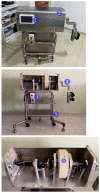Development of a Control Strategy in an Isokinetic Device for Physical Rehabilitation
- PMID: 37447677
- PMCID: PMC10346891
- DOI: 10.3390/s23135827
Development of a Control Strategy in an Isokinetic Device for Physical Rehabilitation
Abstract
Robotic-assisted rehabilitation is currently being applied to improve the effectiveness of human gait rehabilitation and recover the mobility and strength after a stroke or spinal cord injury; a robotic assistant can allow the active participation of the patient and the supervision of the collected data and decrease the labor required from therapists during the patient's training exercises. The goal of gait rehabilitation with robotic-based assistance is to restore motor function by using diverse control strategies, taking account of the physical interaction with the lower limbs of the patient. Over the last few years, researchers have extracted useful information from the patient's biological signals that can effectively reflect movement intention and muscle activation. One way to evaluate progress in rehabilitation is through isokinetic prototype tests that describe the dynamic characteristics of an isokinetic leg extension device for rehabilitation and control action. These tests use an isokinetic system to assess muscle strength and performance in a patient during isometric or isokinetic contraction. An experimental prototype shown in the following work allows the device's performance to be evaluated in a controlled environment before the patient's use. New features provide a control system that can be teleoperated for distributed structures, enabling the remote operation and management of the device. In order to achieve physical recovery from musculoskeletal injuries in the lower limbs and the reintegration of the affected subject into society as an independent and autonomous individual in their daily activities, a control model that introduces a medical isokinetic rehabilitation protocol is presented, in which the element that carries out such protocol consists of a magnetic particle brake whose control action is strongly influenced by the dynamics of the system when in contact with the end user-specifically, the patient's legs in the stretch from the knee to the ankle. The results of these tests are valuable for health professionals seeking to measure their patient's progress during the rehabilitation process and determine when it is safe and appropriate to advance in their treatment.
Keywords: dynamic modeling; dynamometry; electric brake control; isokinetic; isokinetic control; rehabilitation.
Conflict of interest statement
The authors have no conflict of interest to declare.
Figures















Similar articles
-
Isokinetic Muscle Strengthening of the Lower Limbs in People with Stroke: A Systematic Review of Randomized Controlled Trials.J Clin Med. 2025 Mar 25;14(7):2215. doi: 10.3390/jcm14072215. J Clin Med. 2025. PMID: 40217666 Free PMC article. Review.
-
Awakening the control of the ankle dorsiflexors in the post-stroke hemiplegic subject to improve walking activity and social participation: the WAKE (Walking Ankle isoKinetic Exercise) randomised, controlled trial.Trials. 2022 Aug 16;23(1):661. doi: 10.1186/s13063-022-06545-w. Trials. 2022. PMID: 35974379 Free PMC article. Clinical Trial.
-
Construction of efficacious gait and upper limb functional interventions based on brain plasticity evidence and model-based measures for stroke patients.ScientificWorldJournal. 2007 Dec 20;7:2031-45. doi: 10.1100/tsw.2007.299. ScientificWorldJournal. 2007. PMID: 18167618 Free PMC article.
-
A unilateral robotic knee exoskeleton to assess the role of natural gait assistance in hemiparetic patients.J Neuroeng Rehabil. 2022 Oct 8;19(1):109. doi: 10.1186/s12984-022-01088-2. J Neuroeng Rehabil. 2022. PMID: 36209096 Free PMC article.
-
Effects of isokinetic muscle strengthening on muscle strength, mobility, and gait in post-stroke patients: a systematic review and meta-analysis.Clin Rehabil. 2019 Mar;33(3):381-394. doi: 10.1177/0269215518815220. Epub 2018 Nov 28. Clin Rehabil. 2019. PMID: 30484329
Cited by
-
A Robot-Assisted Framework for Rehabilitation Practices: Implementation and Experimental Results.Sensors (Basel). 2023 Sep 4;23(17):7652. doi: 10.3390/s23177652. Sensors (Basel). 2023. PMID: 37688108 Free PMC article.
-
Power-free knee rehabilitation robot for home-based isokinetic training.Nat Commun. 2025 Mar 8;16(1):2347. doi: 10.1038/s41467-025-57578-z. Nat Commun. 2025. PMID: 40057479 Free PMC article. Clinical Trial.
-
Isokinetic Muscle Strengthening of the Lower Limbs in People with Stroke: A Systematic Review of Randomized Controlled Trials.J Clin Med. 2025 Mar 25;14(7):2215. doi: 10.3390/jcm14072215. J Clin Med. 2025. PMID: 40217666 Free PMC article. Review.
References
-
- Vidmar M.F., Baroni B.M., Michelin A.F., Mezzomo M., Lugokenski R., Pimentel G.L., Silva M.F. Isokinetic eccentric training is more effective than constant load eccentric training for quadriceps rehabilitation following anterior cruciate ligament reconstruction: A randomized controlled trial. Braz. J. Phys. Ther. 2019;24:424–432. doi: 10.1016/j.bjpt.2019.07.003. - DOI - PMC - PubMed
-
- Sherman W.M., Pearson D., Plyley M., Costill D., Habansky A., Vogelgesang D.A. Isokinetic rehabilitation after surgery: A review of factors which are important for developing physiotherapeutic techniques after knee surgery. Am. J. Sport. Med. 1982;10:155–161. doi: 10.1177/036354658201000307. - DOI - PubMed
-
- Camacho J.A., Chamorro C.D., Sanabria J.A., Caicedo N.G., García J.I. Implementation of a Service-Oriented Architecture for Applications in Physical Rehabilitation. Rev. Fac. Ing. 2017;26:113–121. doi: 10.19053/01211129.v26.n46.2017.7323. - DOI
-
- Delgado G.C., García J.I. Diseño y Construcción de Una Unidad de Rehabilitación de Hombro Teleoperado Que Integra Requerimientos de Diseño Interdisciplinarios. Cali, Colombia, March 2017. [(accessed on 26 May 2023)]. Available online: https://bibliotecadigital.univalle.edu.co/bitstream/handle/10893/12063/2...
MeSH terms
LinkOut - more resources
Full Text Sources
Medical

